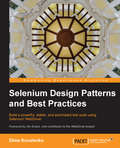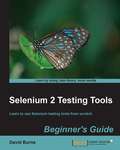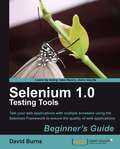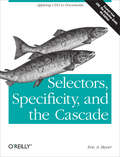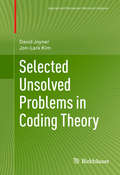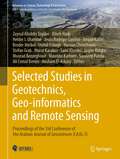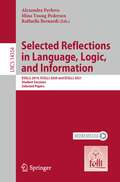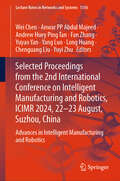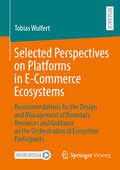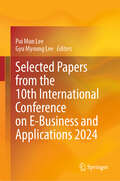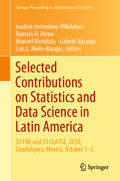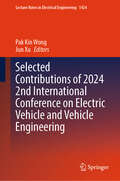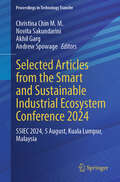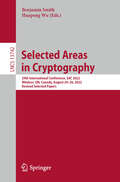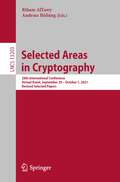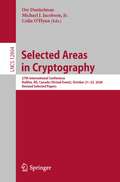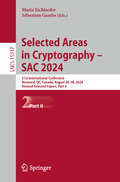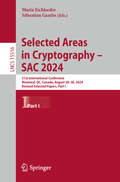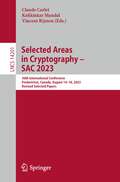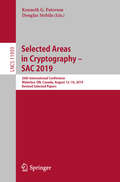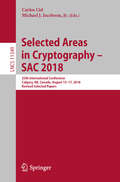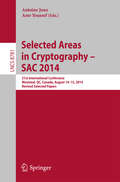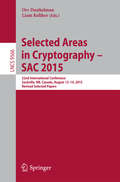- Table View
- List View
Selenium Design Patterns and Best Practices
by Dima KovalenkoWhether you are an experienced WebDriver developer or someone who was newly assigned a task to create automated tests, this book is for you. Since the ideas and concepts are described in simple terms, no previous experience in computer coding or programming is required.
Selenium 2 Testing Tools: Beginner’s Guide
by David BurnsThis book is written in Beginner's Guide style which emphasizes the concept of learning by doing. The book is packed with examples and code so that you can get the best out of this book. If you are a Software Quality Assurance professional, Software Project Manager, or a Software Developer interested in automated testing using Selenium, this book is for you. Web-based application developers will also benefit from this book.
Selenium 1.0 Testing Tools: Beginner’s Guide
by David BurnsWritten with a fast-paced but friendly and engaging approach, this Packt Beginner's Guide is designed to be placed alongside the computer as your guide and mentor. Step-by-step tutorials are bolstered by explanations of the reasoning behind what you are doing. You will quickly pick up the necessary skills, tips, and tricks for creating successful tests for your web applications with practical examples that help you to learn by experiment and play.If you are a Software quality assurance professional, software project manager, or software developer interested in developing automated testing in web based applications, then this book is definitely for you.
Selectors, Specificity, and the Cascade: Applying CSS3 to Documents
by Eric A. MeyerExactly how does the "cascade" in Cascading Style Sheets work? This concise guide demonstrates the power and simplicity of CSS selectors for applying style rules to different web page elements. You’ll learn how your page’s presentation depends on a multitude of style rules and the complex ways they function—and sometimes collide—within the document’s structure.This guide is a chapter from the upcoming fourth edition of CSS: The Definitive Guide. When you purchase either the print or the ebook edition of Selectors, Specificity, and the Cascade, you’ll receive a significant discount on the entire Definitive Guide when it’s released. Why wait when you can learn how to use selectors and other key CSS 3 features right away?Learn how to create CSS rules that apply to a large number of similar elementsGroup rules to make style sheets smaller and download times fasterUnderstand how elements inherit styles from their parentsDiscover how reader and browser preferences affect your page presentationExamine specificity—the method browsers use to choose between two conflicting style rulesGet a handle on how specificity and inheritance combine to form the cascadeGet details on all of the CSS3 selectors
Selected Unsolved Problems in Coding Theory (Applied and Numerical Harmonic Analysis)
by Jon-Lark Kim David JoynerUsing an original mode of presentation, and emphasizing the computational nature of the subject, this book explores a number of the unsolved problems that still exist in coding theory. A well-established and highly relevant branch of mathematics, the theory of error-correcting codes is concerned with reliably transmitting data over a 'noisy' channel. Despite frequent use in a range of contexts, the subject still contains interesting unsolved problems that have resisted solution by some of the most prominent mathematicians of recent decades. Employing Sage--a free open-source mathematics software system--to illustrate ideas, this book is intended for graduate students and researchers in algebraic coding theory. The work may be used as supplementary reading material in a graduate course on coding theory or for self-study.
Selected Studies in Geotechnics, Geo-informatics and Remote Sensing: Proceedings of the 3rd Conference of the Arabian Journal of Geosciences (CAJG-3) (Advances in Science, Technology & Innovation)
by Jasper Knight Sandeep Panda Broder Merkel Stefan Grab Sami Khomsi Amjad Kallel Haroun Chenchouni Murat Karakus Mehdi Eshagh Helder I. Chaminé Maurizio Barbieri Hesham El-Askary Jesús Rodrigo-Comino Ali Cemal Benim Zeynal Abiddin Ergüler Riheb Hadji Mourad BezzeghoudThis book contains the best papers accepted for presentation at the 3rd Springer Conference of the Arabian Journal of Geosciences (CAJG-3). The book is divided into three parts to distinguish research studies from the fields of (1) geological and geotechnical engineering, (2) geomechanical studies based on numerical and analytical methods, and (3) geo-informatics and remote sensing. The content of these papers provides new scientific knowledge for further understanding on landslides, new stabilization techniques, importance of geophysics for engineering geology investigations as well as new empirical approaches for easily predicting some physical and hydrogeomechanical properties of geomaterials. It also sheds the light on usage of different remote sensing technologies, mapping techniques in a geographic information systems environment along with some advanced signal processing, and deep learning approaches. The book is of interest to all researchers, practitioners, and students in the fields of geological and mining engineering, geotechnical engineering, hydrogeomechanics, engineering geology, geotechnologies, groundwater and natural hazards, and analyses of some emerging earth processes and environmental variabilities.
Selected Reflections in Language, Logic, and Information: ESSLLI 2019, ESSLLI 2020 and ESSLLI 2021 Student Sessions, Selected Papers (Lecture Notes in Computer Science #14354)
by Raffaella Bernardi Alexandra Pavlova Mina Young PedersenThe European Summer School in Logic, Language and Information (ESSLLI) is organized every year by the Association for Logic, Language and Information (FoLLI) in different sites around Europe. The papers cover vastly dierent topics, but each fall in the intersection of the three primary topics of ESSLLI: Logic, Language and Computation. The 13 papers presented in this volume have been selected among 81 submitted papers over the years 2019, 2020 and 2021. The ESSLLI Student Session is an excellent venue for students to present their work and receive valuable feedback from renowned experts in their respective fields. The Student Session accepts submissions for three different tracks: Language and Computation (LaCo), Logic and Computation (LoCo), and Logic and Language (LoLa).
Selected Proceedings from the 2nd International Conference on Intelligent Manufacturing and Robotics, ICIMR 2024, 22-23 August, Suzhou, China: Advances in Intelligent Manufacturing and Robotics (Lecture Notes in Networks and Systems #1316)
by Fan Zhang Wei Chen Long Huang Anwar PP Abdul Majeed Andrew Huey Ping Tan Yuyao Yan Yang Luo Chenguang Liu Yuyi ZhuThis book presents proceedings from the 2nd International Conference on Intelligent Manufacturing and Robotics, ICIMR 2024 Held on 22 and 23 August in Suzhou, China. This proceedings deliberates on the key challenges, engineering and scientific discoveries, innovations, and advances on intelligent manufacturing and robotics that are non-trivial through the lens of Industry 4.0. In this book, traditional and modern solutions that are employed across the spectrum of various intelligent manufacturing and robotics contexts are presents. The readers are expected to gain an insightful view on the current trends, issues, mitigating factors as well as proposed solutions from this book.
Selected Perspectives on Platforms in E-Commerce Ecosystems: Recommendations for the Design and Management of Boundary Resources and Guidance on the Orchestration of Ecosystem Participants
by Tobias WulfertDigital platforms hold significant economic value, enriching various industry sectors. While they are pivotal in driving value creation and capture, it is not solely their technological prowess that underpins their economic significance. Rather, their effectiveness lies in their integration within business ecosystems. In this study, Tobias Wulfert examines digital platforms in the context of e-commerce through five lenses: · Enterprise architecture · Boundary resources · Application lifecycle · Dynamic capabilities · Value creation This analysis focuses on different e-commerce platform types, developing an architectural framework and a taxonomy for classification. The author also delineates e-commerce ecosystem architectures, emphasizing the role of platforms as central components and the involvement of peripheral ecosystem participants. He explores boundary resources as crucial interfaces between platforms and ecosystem participants. He further suggests a reference procedure model for the management of these boundary resources. Furthermore, he delves into the dynamic capabilities necessary for effective ecosystem orchestration, identifying configurations of dynamic capabilities that can confer sustainable competitive advantages.
Selected Papers from the 10th International Conference on E-Business and Applications 2024
by Pui Mun Lee Gyu Myoung LeeThis book brings together original, peer-reviewed research papers from the 2024 10th International Conference on E-Business and Applications, held in Singapore from February 26 to 28, 2024. The papers delve into AI-enabled business innovation, data-driven value creation, and the emerging IoT landscape, providing in-depth insights into these rapidly evolving fields. The book bridges the gap between business intelligence, artificial intelligence, and e-commerce trading technologies, offering a holistic perspective on the intersection of these disciplines. Readers can gain valuable knowledge through real-world examples, data visualization techniques, and business analytics applications, enhancing their understanding of how these concepts translate into tangible business outcomes.
Selected Contributions on Statistics and Data Science in Latin America: 33 FNE and 13 CLATSE, 2018, Guadalajara, Mexico, October 1−5 (Springer Proceedings in Mathematics & Statistics #301)
by Ramsés H. Mena Isadora Antoniano-Villalobos Manuel Mendoza Lizbeth Naranjo Luis E. Nieto-BarajasThe volume includes a collection of peer-reviewed contributions from among those presented at the main conference organized yearly by the Mexican Statistical Association (AME) and every two years by a Latin-American Confederation of Statistical Societies. For the 2018 edition, particular attention was placed on the analysis of highly complex or large data sets, which have come to be known as “big data”. Statistical research in Latin America is prolific and research networks span within and outside the region. The goal of this volume is to provide access to selected works from Latin-American collaborators and their research networks to a wider audience. New methodological advances, motivated in part by the challenges of a data-driven world and the Latin American context, will be of interest to academics and practitioners around the world.
Selected Contributions of 2024 2nd International Conference on Electric Vehicle and Vehicle Engineering (Lecture Notes in Electrical Engineering #1424)
by Jun Xu Pak Kin WongThis book presents an extensive exploration of the latest trends in Electric Vehicle and the boundless opportunities they offer. It has encompassed various facets including Intelligent Vehicle, Electric Vehicle Technology, Power Electronics and Motor Drives, Energy Systems and Storage, Electronic Control Systems, Battery Technologies, Autonomous and Connected Vehicles. The book is tailored for researchers, engineers, and practitioners deeply involved in the field of Electric Vehicle. It delves into the intricate technicalities of EV technology, providing profound insights and comprehensive discussions on its fundamental principles.
Selected Articles from the Smart and Sustainable Industrial Ecosystem Conference 2024: SSIEC 2024, 5 August, Kuala Lumpur, Malaysia (Proceedings in Technology Transfer)
by Akhil Garg Christina Chin M. M. Novita Sakundarini Andrew SpowageThis book presents selected peer reviewed articles from the Smart and Sustainable Industrial Ecosystem Conference 2024 (SSIEC 2024), that took place on 5 August 2024in The Kuala Lumpur Teaching Centre, Kuala Lumpur, Malaysia. The collection catered for articles sharing new insights and research developments by academicians and industry experts on the theme that aligns with United Nations SGD 9 (build resilient infrastructure, promote inclusive and sustainable industrialization and foster innovation) and 11 (make cities and human settlements inclusive, safe, resilient, and sustainable). Topics covered include renewable energy systems, advanced sustainable materials technologies, energy-efficient process and mechanical systems, smart manufacturing, and green and sustainable manufacturing. The book will appeal to sustainable energy consultants, mechanical and manufacturing engineers.
Selected Articles from the International Conference on Sustainable Fashion and Technical Textiles: ICSFT-2024: 12 November, Jalandhar, India (Proceedings in Technology Transfer)
by Ashish Kapoor Payal Bansal Sudev Dutta C. C. Reddy Prabhuraj VenkatramanThis book includes peer reviewed articles from ICSFT-2024 held on 12 November at Jalandhar in India. It highlights the future of eco-friendly fashion and the development of advanced textile technologies and practices to reduce the environmental impact of fashion industry. It encompasses the creation and application of new materials, production processes, and design strategies that prioritize sustainability, resource efficiency, and reduced waste. It highlights the integration of eco-friendly practices in textile manufacturing, such as the use of biodegradable fibers, recycled materials, and sustainable dyeing techniques, aiming to transform the fashion industry into a more environmentally responsible sector while maintaining high performance and functionality in textiles. By highlighting successful case studies and emerging trends, the book provides a comprehensive overview of how sustainability is being integrated into the technical textiles sector. Perfect for professionals, researchers, and enthusiasts, this resource underscores the importance of sustainability in creating a more responsible and environmentally friendly fashion landscape.
Selected Areas in Cryptography: 29th International Conference, SAC 2022, Windsor, ON, Canada, August 24–26, 2022, Revised Selected Papers (Lecture Notes in Computer Science #13742)
by Benjamin Smith Huapeng WuThis book constitutes the refereed post-conference proceedings of the 29th International Conference on Selected Areas in Cryptography, SAC 2022, held in Windsor, Canada, during August 24–26, 2022. The 21 full papers presented in this volume were carefully reviewed and selected from 53 submissions. The papers are categorized into the following topical sections: lattices and ECC; differential cryptanalysis; cryptographic primitives; isogeny-based cryptography I; block ciphers; differential cryptanalysis II; isogeny-based cryptography II; and protocols and PRFs.
Selected Areas in Cryptography: 28th International Conference, Virtual Event, September 29 – October 1, 2021, Revised Selected Papers (Lecture Notes in Computer Science #13203)
by Riham AlTawy Andreas HülsingThis book contains revised selected papers from the 28th International Conference on Selected Areas in Cryptography, SAC 2021, held as a virtual event September and October 2021.* The 23 full papers presented in this volume were carefully reviewed and selected from 60 submissions. They cover the following research areas: design and analysis of symmetric key primitives and cryptosystems, including block and stream ciphers, hash functions, MAC algorithms, and authenticated encryption schemes, efficient implementations of symmetric and public key algorithms, mathematical and algorithmic aspects of applied cryptology, and secure elections and related cryptographic constructions. *The conference was originally planned to take place at the University of Victoria, BC, Canada. Due to the COVID-19 pandemic, it was held virtually.
Selected Areas in Cryptography: 27th International Conference, Halifax, NS, Canada (Virtual Event), October 21-23, 2020, Revised Selected Papers (Lecture Notes in Computer Science #12804)
by Orr Dunkelman Michael J. Jacobson Jr. Colin O’FlynnThis book contains revised selected papers from the 27th International Conference on Selected Areas in Cryptography, SAC 2020, held in Halifax, Nova Scotia, Canada in October 2020. The 27 full papers presented in this volume were carefully reviewed and selected from 52 submissions. They cover the following research areas: design and analysis of symmetric key primitives and cryptosystems, including block and stream ciphers, hash functions, MAC algorithms, and authenticated encryption schemes, efficient implementations of symmetric and public key algorithms, mathematical and algorithmic aspects of applied cryptology, and secure elections and related cryptographic constructions
Selected Areas in Cryptography – SAC 2024: 31st International Conference, Montreal, QC, Canada, August 28–30, 2024, Revised Selected Papers, Part II (Lecture Notes in Computer Science #15517)
by Maria Eichlseder Sébastien GambsThis two-volume set LNCS 15516-15517 contains revised selected papers from the 31st International Conference on Selected Areas in Cryptography, SAC 2024, held in Montreal, QC, Canada, in August 2024. The 25 full papers presented in these proceedings were carefully reviewed and selected from 95 submissions. The papers are organized in the following topical sections: Part I: Privacy-preserving cryptography; post-quantum cryptography; attacks on public-key cryptography; and identity-based encryption. Part II: Authenticated encryption; symmetric design strategies; cryptanalysis of arithmetization-oriented primitives; symmetric primitive design; and implementations and side-channel analysis.
Selected Areas in Cryptography – SAC 2024: 31st International Conference, Montreal, QC, Canada, August 28–30, 2024, Revised Selected Papers, Part I (Lecture Notes in Computer Science #15516)
by Maria Eichlseder Sébastien GambsThis two-volume set LNCS 15516-15517 contains revised selected papers from the 31st International Conference on Selected Areas in Cryptography, SAC 2024, held in Montreal, QC, Canada, in August 2024. The 25 full papers presented in these proceedings were carefully reviewed and selected from 95 submissions. The papers are organized in the following topical sections: Part I: Privacy-preserving cryptography; post-quantum cryptography; attacks on public-key cryptography; and identity-based encryption. Part II: Authenticated encryption; symmetric design strategies; cryptanalysis of arithmetization-oriented primitives; symmetric primitive design; and implementations and side-channel analysis.
Selected Areas in Cryptography – SAC 2023: 30th International Conference, Fredericton, Canada, August 14–18, 2023, Revised Selected Papers (Lecture Notes in Computer Science #14201)
by Claude Carlet Vincent Rijmen Kalikinkar MandalThis book contains revised selected papers from the 30th International Conference on Selected Areas in Cryptography, SAC 2023, held in Fredericton, New Brunswick, Canada, in August 2023.The 21full papers presented in these proceedings were carefully reviewed and selected from 45 submissions. The papers are organized in the following topical sections: Cryptanalysis of Lightweight Ciphers; Side-Channel Attacks and Countermeasures; Post-Quantum Constructions; Symmetric cryptography and fault attacks; Post-Quantum Analysis and Implementations; Homomorphic encryption; Public-Key Cryptography; and Differential Cryptanalysis.
Selected Areas in Cryptography – SAC 2019: 26th International Conference, Waterloo, ON, Canada, August 12–16, 2019, Revised Selected Papers (Lecture Notes in Computer Science #11959)
by Douglas Stebila Kenneth G. PatersonThis book contains revised selected papers from the 26th International Conference on Selected Areas in Cryptography, SAC 2019, held in Waterloo, ON, Canada, in August 2019. The 26 full papers presented in this volume were carefully reviewed and selected from 74 submissions. They cover the following research areas: Design and analysis of symmetric key primitives and cryptosystems, including block and stream ciphers, hash functions, MAC algorithms, and authenticated encryption schemes, efficient implementations of symmetric and public key algorithms, mathematical and algorithmic aspects of applied cryptology, cryptography for the Internet of Things.
Selected Areas in Cryptography – SAC 2018: 25th International Conference, Calgary, AB, Canada, August 15–17, 2018, Revised Selected Papers (Lecture Notes in Computer Science #11349)
by Carlos Cid Michael J. Jacobson Jr.This book contains revised selected papers from the 25th International Conference on Selected Areas in Cryptography, SAC 2018, held in Calgary, AB, Canada in August 2018. The 22 full papers presented in this volume were carefully reviewed and selected from 57 submissions. They cover the following research areas:design and analysis of symmetric key primitives and cryptosystems, including block and stream ciphers, hash functions, MAC algorithms, and authenticated encryption schemesefficient implementations of symmetric and public key algorithmsmathematical and algorithmic aspects of applied cryptologycryptography for the Internet of Things
Selected Areas in Cryptography -- SAC 2014
by Antoine Joux Amr YoussefThis book constitutes the proceedings of the 21st International Conference on Selected Areas in Cryptography, SAC 2014, held in Montreal, QC, Canada, in August 2014. The 22 papers presented in this volume were carefully reviewed and selected from 103 submissions. There are four areas covered at each SAC conference. The three permanent areas are: design and analysis of symmetric key primitives and cryptosystems, including block and stream ciphers, hash function, MAC algorithms, cryptographic permutations, and authenticated encryption schemes; efficient implementations of symmetric and public key algorithms; mathematical and algorithmic aspects of applied cryptology. This year, the fourth area for SAC 2014 is: algorithms for cryptography, cryptanalysis and their complexity analysis.
Selected Areas in Cryptography -- SAC 2013
by Kristin Lauter Tanja Lange Petr LisoněkThis book constitutes the proceedings of the 20th International Conference on Selected Areas in Cryptography, SAC 2013, held in Burnaby, Canada, in August 2013. The 26 papers presented in this volume were carefully reviewed and selected from 98 submissions. They are organized in topical sections named: lattices; discrete logarithms; stream ciphers and authenticated encryption; post-quantum (hash-based and system solving); white box crypto; block ciphers; elliptic curves, pairings and RSA; hash functions and MACs; and side-channel attacks. The book also contains 3 full-length invited talks.
Selected Areas in Cryptography - SAC 2015
by Orr Dunkelman Liam KeliherThis bookcontains revised selected papers from the 22nd International Conference onSelected Areas in Cryptography, SAC 2015, held in Sackville, NB, Canada inAugust 2015. The 26 full papers and 3 short papers presented in this volume were carefullyreviewed and selected from 91 submissions. They are organized in topicalsections named: privacy enhancing technologies; cryptanalysis of symmetric-keyprimitives; implementation of cryptographic schemes; short papers; privacypreserving data processing; side channel attacks and defenses; newcryptographic constructions; authenticated encryption; on the hardness ofmathematical problems; and cryptanalysis of authenticated encryption schemes.
